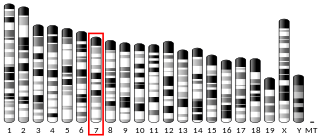
Keratin, type I cytoskeletal 19 (Keratin-19)) also known as cytokeratin-19 (CK-19) is a 40 kDa protein that in humans is encoded by the KRT19 gene. Keratin-19 is a type I keratin.
The prolactin receptor (PRLR) is a type I cytokine receptor encoded in humans by the PRLR gene on chromosome 5p13-14. It is the receptor for prolactin (PRL). The PRLR can also bind to and be activated by growth hormone (GH) and human placental lactogen (hPL). The PRLR is expressed in the mammary glands, pituitary gland, and other tissues. It plays an important role in lobuloalveolar development of the mammary glands during pregnancy and in lactation.

Cytochrome P450 17A1 is an enzyme of the hydroxylase type that in humans is encoded by the CYP17A1 gene on chromosome 10. It is ubiquitously expressed in many tissues and cell types, including the zona reticularis and zona fasciculata of the adrenal cortex as well as gonadal tissues. It has both 17α-hydroxylase and 17,20-lyase activities, and is a key enzyme in the steroidogenic pathway that produces progestins, mineralocorticoids, glucocorticoids, androgens, and estrogens. More specifically, the enzyme acts upon pregnenolone and progesterone to add a hydroxyl (-OH) group at carbon 17 position (C17) of the steroid D ring, or acts upon 17α-hydroxyprogesterone and 17α-hydroxypregnenolone to split the side-chain off the steroid nucleus.
Secretoglobins (SCGBs) are a family of small, alpha-helical, disulfide linked, dimeric proteins found only in mammals. This family was formerly known as the Uteroglobin/Clara cell 10-kDa family, after the two aliases of its founding member Uteroglobin.

The nuclear receptor coactivator 3 also known as NCOA3 is a protein that, in humans, is encoded by the NCOA3 gene. NCOA3 is also frequently called 'amplified in breast 1' (AIB1), steroid receptor coactivator-3 (SRC-3), or thyroid hormone receptor activator molecule 1 (TRAM-1).

Growth hormone 1, also known as pituitary growth hormone or simply as growth hormone (GH) somatotropin, is a protein that in humans is encoded by the GH1 gene.

HSD3B1 is a human gene that encodes for a 3beta-hydroxysteroid dehydrogenase/delta(5)-delta(4)isomerase type I or hydroxy-delta-5-steroid dehydrogenase, 3 beta- and steroid delta-isomerase 1. While it can carry out the same function as HSD3B2, it localizes primarily to different tissues, such as the placenta and nonsteroidogenic tissues. Its requirement for the production of progesterone by the placenta, which has a vital role in pregnancy, may be one reason why no disease based on mutations in this gene has been identified to date, besides prostate cancer.

3-Oxo-5α-steroid 4-dehydrogenase 1 is an enzyme that in humans is encoded by the SRD5A1 gene. It is one of three forms of steroid 5α-reductase.

Cadherin-3, also known as P-Cadherin, is a protein that in humans is encoded by the CDH3 gene.

Aldo-keto reductase family 1 member C3 (AKR1C3), also known as 17β-hydroxysteroid dehydrogenase type 5 or 3α-hydroxysteroid dehydrogenase type 2 (3α-HSD2) is a steroidogenic enzyme that in humans is encoded by the AKR1C3 gene.

MAX-interacting protein 1 is a protein that in humans is encoded by the MXI1 gene.

Kallikrein-related peptidase 4 is a protein which in humans is encoded by the KLK4 gene.

Kallikrein-11 is a protein that in humans is encoded by the KLK11 gene.

Zinc finger homeobox protein 3 is a protein that in humans is encoded by the ZFHX3 gene.

Kallikrein-13 is a protein that in humans is encoded by the KLK13 gene.

Mammaglobin-A also known as secretoglobin family 2A member 2 is a protein that in humans is encoded by the SCGB2A2 gene.

Kallikrein-15 is a protein that in humans is encoded by the KLK15 gene.

Mammaglobin-B also known as secretoglobin family 2A member 1 is a protein that in humans is encoded by the SCGB2A1 gene.

Zinc transporter ZIP9, also known as Zrt- and Irt-like protein 9 (ZIP9) and solute carrier family 39 member 9, is a protein that in humans is encoded by the SLC39A9 gene. This protein is the 9th member out of 14 ZIP family proteins, which is a membrane androgen receptor (mAR) coupled to G proteins, and also classified as a zinc transporter protein. ZIP family proteins transport zinc metal from the extracellular environment into cells through cell membrane.
Darrick Carter is an American biochemist/biophysicist, inventor, and entrepreneur. He is known for developing various therapeutics and vaccines, such as saRNA COVID-19 vaccine, influenza vaccine, and tuberculosis vaccine. Currently, he is the CEO of Compliment Corporation, and PAI Life Sciences Incorporated, as well as Founder of HDT Bio Corporation. He also holds two affiliate Professorships at the University of Washington in the Schools of Medicine and in Global Health.

















